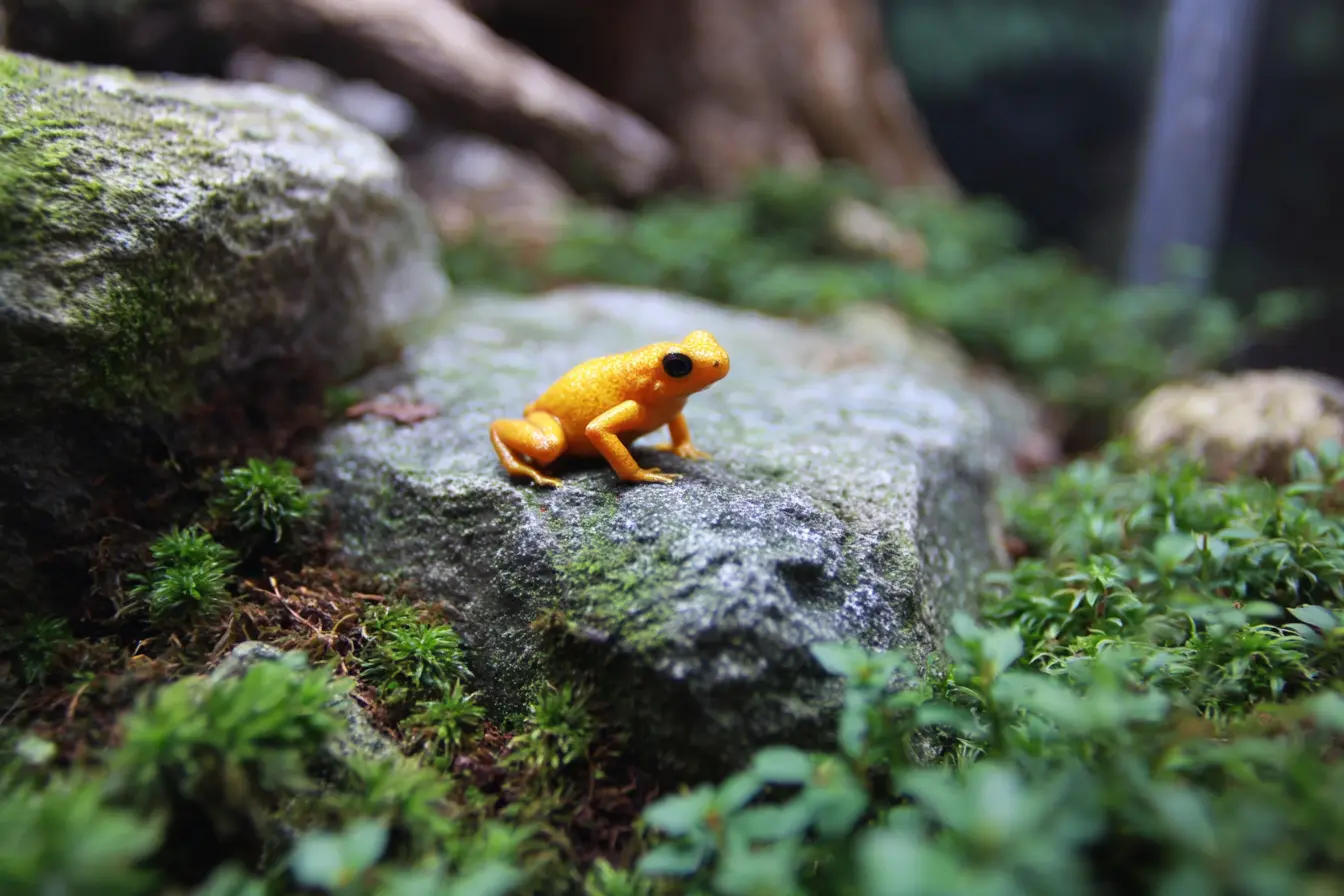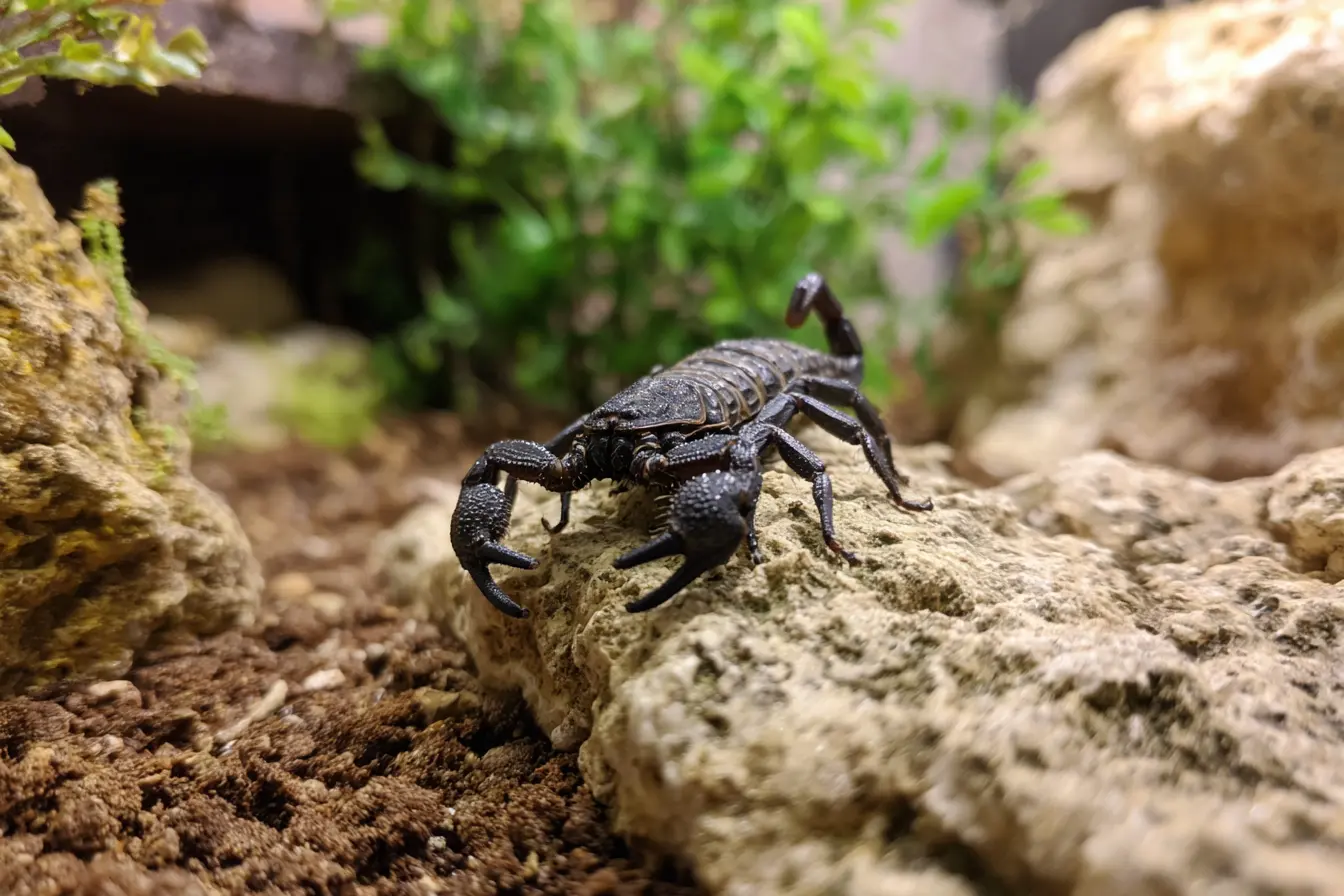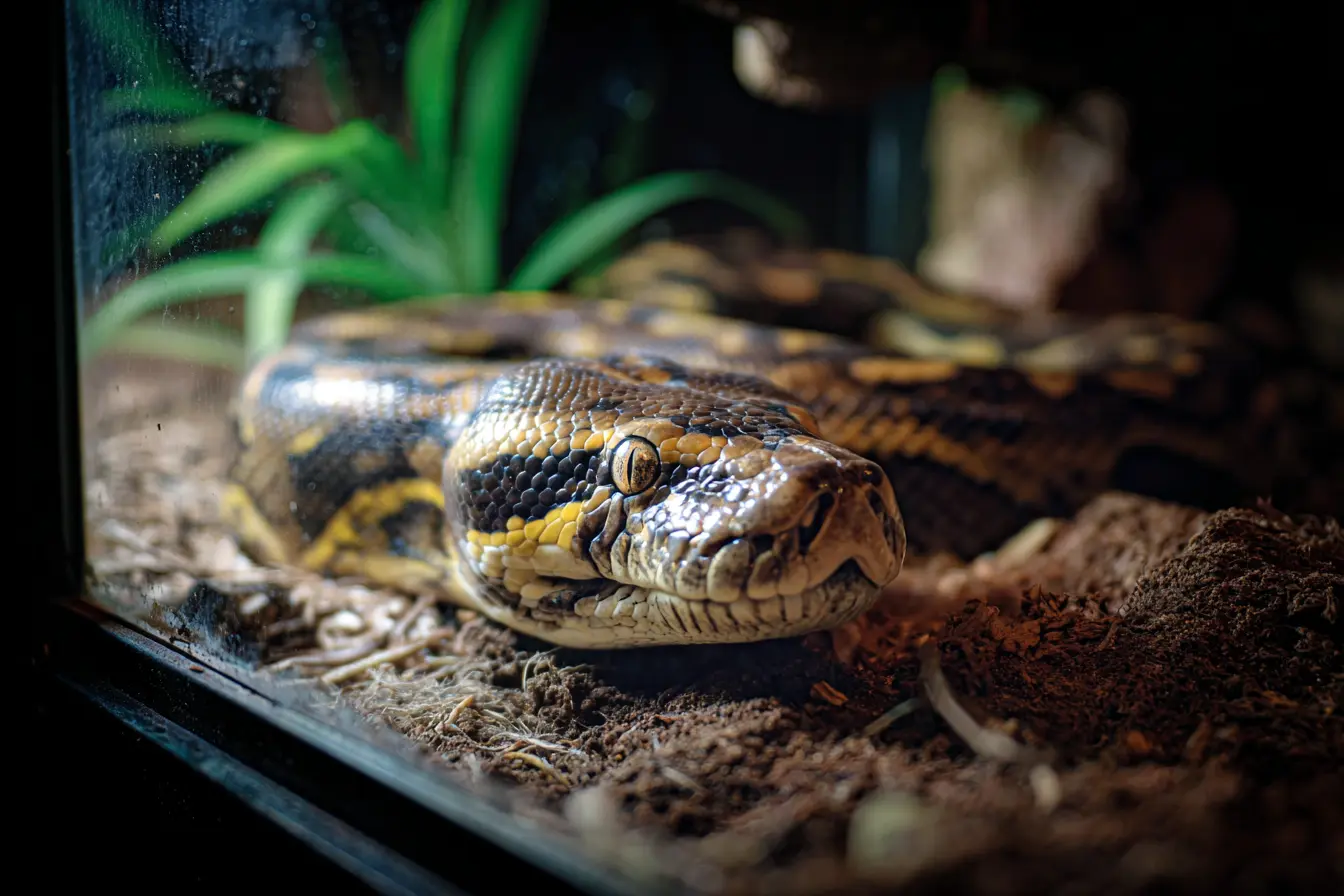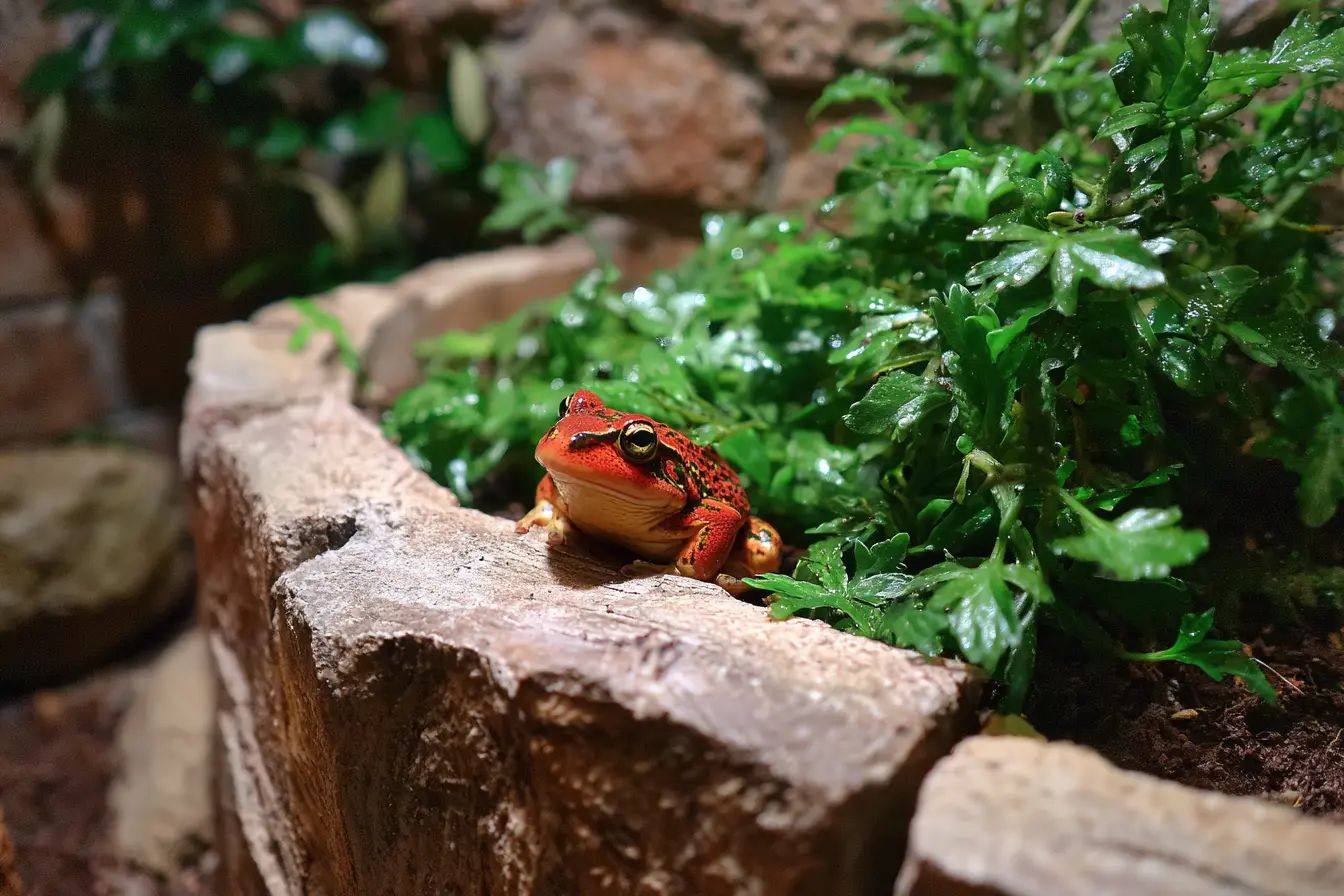
Keeping the Golden Mantella
The Golden Mantella (Mantella aurantiaca) is one of the most visually stunning and endangered amphibians in the world. Native to the rainforests of central-eastern Madagascar, these tiny, bright orange frogs are known for their vibrant coloration, social behaviours, and unique calls. Though small in size, they require a carefully maintained habitat to thrive, making them suitable for keepers who are committed to replicating their natural environment.
This guide covers everything you need to know about caring for Golden Mantellas in captivity.
Physical Characteristics
Size
- Adults are very small, typically reaching just 2–2.5 cm (0.8–1 inch) in length.
Lifespan
- With proper care, Golden Mantellas can live up to 8 years in captivity, though 4–6 years is more typical.
Colouration and Skin Texture
- Their bright orange to yellowish skin acts as a warning to predators about their toxicity.
- Skin is smooth and slightly moist, requiring a high-humidity environment to remain healthy.
Sexual Dimorphism
- Females are slightly larger and rounder than males.
- Males have a more prominent vocal sac and emit high-pitched, repetitive calls, especially during the breeding season.
Legal Considerations and Conservation
Golden Mantellas are critically endangered in the wild due to habitat destruction, climate change, and overcollection for the pet trade. Captive breeding programs are essential for the species' conservation. Always purchase captive-bred individuals from ethical breeders and never support illegal wildlife trade.
Housing and Enclosure Setup
Golden Mantellas are terrestrial and diurnal frogs that thrive in well-planted, bioactive enclosures that simulate their native rainforest habitat.
Tank Size
- A 40-litre (10-gallon) tank is sufficient for a small group (3–4 frogs), as they are social animals.
- Horizontal space is more important than vertical, but a larger tank offers more stability and enrichment.
Substrate
- Use a moisture-retentive, bioactive substrate such as:
- A bottom drainage layer (e.g., clay pebbles or LECA)
- Barrier mesh
- A mix of coconut fiber, sphagnum moss, leaf litter, and organic topsoil
- Keep the substrate damp but not waterlogged.
Enclosure Furnishings
- Provide abundant cover with live or fake plants, cork bark, leaf litter, and moss.
- Offer multiple hides and visual barriers to reduce stress.
- A shallow water dish is optional but misting is the primary water source.
Temperature and Humidity
- Day temperature: 22–26°C (72–79°F)
- Night temperature: 18–21°C (65–70°F)
- Humidity: 80–100%
- Mist 2–3 times daily or use an automated misting system.
- Proper airflow is crucial to prevent mold growth and respiratory issues.
Lighting
- Provide a 12-hour day/night light cycle using full-spectrum LED or fluorescent lights.
- Low-intensity UVB (2.0 or 5.0) is optional but may support overall health.
Diet and Feeding
Golden Mantellas are insectivores with a preference for small, moving prey. Due to their tiny size, all food items must be appropriately small.
Suitable Food Items
- Springtails
- Drosophila melanogaster (flightless fruit flies)
- Pinhead crickets
- Isopods (small species or juveniles)
- Aphids and micro-worms (occasionally)
Feeding Schedule
- Feed daily or every other day.
- Provide enough food for them to eat within 10–15 minutes.
- Remove uneaten prey to avoid stress or contamination.
Supplementation
- Dust prey with calcium powder at every other feeding.
- Use a high-quality multivitamin supplement once or twice per week.
- Rotate supplements to ensure balanced nutrition.
Social Behaviour and Handling
Golden Mantellas are social and should be kept in groups, ideally 3–6 individuals. Watching their interactions can be very rewarding.
Behaviour
- Active during the day (diurnal).
- Males often call during the morning or after misting.
- Territorial sparring between males is common but rarely harmful.
- They may retreat into hides or under leaves when stressed.
Handling
- Avoid direct handling. Their skin is sensitive and easily absorbs oils, chemicals, and heat from human hands.
- If handling is necessary, use powder-free gloves moistened with dechlorinated water.
Health and Common Issues
Golden Mantellas are sensitive to environmental changes, and improper care can quickly lead to health problems.
Common Health Issues
- Dehydration: Due to low humidity or insufficient misting.
- Nutritional Deficiencies: Caused by inadequate supplementation or poor prey variety.
- Parasites: Particularly in wild-caught or poorly quarantined individuals.
- Respiratory infections: Stemming from poor ventilation or too much moisture.
Preventative Care
- Keep the enclosure clean and bioactive if possible.
- Maintain strict temperature and humidity ranges.
- Quarantine new frogs for at least 30 days.
- Offer varied, well-supplemented food sources.
Breeding Golden Mantellas
Breeding is possible in captivity but requires mimicking seasonal cues.
Breeding Triggers
- Simulate a dry season for several weeks with reduced misting and lower humidity.
- Follow this with heavy misting and increased humidity to simulate the rainy season.
- Increase feeding with calcium-rich prey.
Courtship and Egg-Laying
- Males call frequently, attracting females to moist areas such as under leaf litter or moss.
- Eggs are laid in damp terrestrial spots, usually in clusters of 10–30.
- After laying, transfer eggs to a shallow container with moist sphagnum moss to prevent fungal growth.
Tadpole Care
- Eggs hatch in 7–14 days.
- Tadpoles are aquatic and should be moved to shallow water containers with dechlorinated water.
- Feed with spirulina powder, algae wafers, and finely crushed fish food.
- Metamorphosis occurs after 6–10 weeks.
Conclusion
Golden Mantellas are brilliant, captivating frogs that offer an unparalleled visual and auditory display in a well-maintained terrarium. However, they are not "easy" pets and require careful attention to humidity, temperature, and nutrition. For keepers interested in conservation-minded amphibian care and willing to meet their specific environmental needs, Golden Mantellas can be incredibly rewarding to keep—and even to breed.
With their vibrant color, social nature, and conservation importance, the Golden Mantella makes a striking and meaningful addition to any amphibian enthusiast’s collection.
Vets near you
Speciality vets
- Aquatics vet specialists
- Birds vet specialists
- Camelids vet specialists
- Cats vet specialists
- Cattle vet specialists
- Deer vet specialists
- Dogs vet specialists
- Equines vet specialists
- Exotic vet specialists
- Goats vet specialists
- Pigs vet specialists
- Poultry vet specialists
- Sheep vet specialists
- Small Mammals vet specialists
- Wild vet specialists



